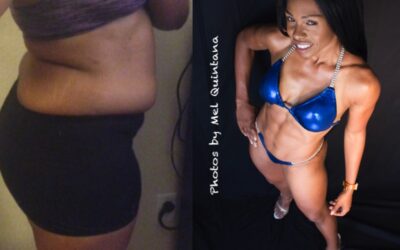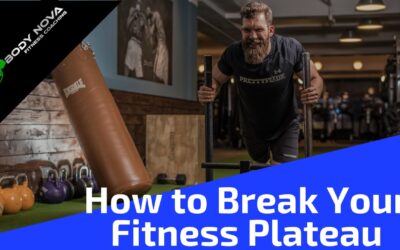Why Your Booty Program Isn’t Working
(Or Why Your Glutes Stopped Growing)
Booty Building is a real thing. In fact having well developed glutes for women is starting to become as essential for women as having well developed arms or chest is for men. Since this new increased interest in booty building has risen, we need to understand that glutes are just like any other muscle. If your booty building, you’re trying to pack on as much muscle in that part of the body as possible. So the same rules that apply to people trying to get bigger chest, arms, shoulders… also apply to training to build bigger rounder glutes. Yes the same rules that apply to apply to bodybuilding, also apply to booty building. Since these same rules apply, people tend to make the same mistakes. So I’ll let this be a guide to help you troubleshoot your booty building efforts, so if you’re stuck in a plateau, you’ll be able to figure out Why Your Booty Program Isn’t Working anymore.
- Nutrition Doesn’t Match Your Goals This is a situation that I’ve come across numerous times. I’ve talked to women that took in as little as 900 calories per day, while not only expecting to build muscle, to also to help them build bigger, rounder, glutes. The materials that the body uses to build muscle has to come from somewhere. That muscle you want to build requires fuel. Calories in vs. Calories out still applies. If you want OPTIMAL growth, you’ll want to start from eating with a calorie surplus. If the fear of getting fat exists, you don’t need to make it a huge surplus. You can eat an extra 200-300 calories/day instead of the larger surpluses that most people try to employ of 500 or 1000 calories extra per day. If you’re not a lean person, larger calorie surpluses are much more likely to result in gaining fat, instead of gaining muscle. Yes, you will put on weight faster, and some of that weight may go to your booty. But, when it comes time to lose weight and get lean, your booty goes with it. In addition to this, people with higher levels of body fat have poor nutrient partitioning. They’re not as good at storing carbs as glycogen, or even getting them to the muscles to use as energy, as those that have lower body fat levels.
Not only does your calorie intake matter, your macros and in particular your protein intake matters. Most people think that it’s only about calories in vs calories out. Research shows that having a protein intake at 1 gram/lb. of body weight increases the chances of your weight gain to beneficial. Meaning that you’ll build more muscle at the same calorie intake. Most people stuck in a plateau for any type of progress, make this mistake. When all other things are equal, those that ate 1 gram of protein per lb. of bodyweight gained more muscle. If you’re someone that has high body fat, but also considerably over weight, you could start with 1 gram/lb. of lean body mass. And then raise your protein intake as you make progress.
Yes there are studies out there that have shown that muscle can be gained in a calorie deficit. But is it optimal? Does the likelihood of you getting your glutes from flab to fab increase? I’d say it’s not optimal. But the thing you need to understand is that in the real world, you need to bend the knowledge to fit your needs. For example, if I was someone trying to build muscle, and drop large amounts of body fat, or even someone taking a diet break with maintenance calories. I might raise my protein intake above 1g/lb. of body weight. Studies show that protein intakes above 1 g/lb. of protein per day resulted in increases in lean body mass, and well as reductions in fat mass.
2. You Suffer From Tin Man Syndrome
Straight from “The Wizard of Oz.” In the story the Tin Man went to see the Wizard to get a heart. In this case, it’s to get some heart. Which is what those with Tin Man Syndrome suffer from. They’re scared of hard work and hard training, as well as training within their abilities. How does this relate to glute training, or booty building? No matter what you’re trying to build or improve, your body has to have a reason to give you the results that you’re seeking. If you’re always trying to stay within your comfort zone, your body (or in this case booty) doesn’t need to build muscle. It can handle the demands that you’re putting on it. Embrace the tasks in front of you and step up to the challenge.
This is basically a concept called General Adaptation Syndrome. For more on that, and how it relates to fitness check out this video: https://www.youtube.com/channel/UC5bl5HA51WB3XF3FADKTWLQ
3. Poor Exercise Selection (and a Lack of Understanding)
In fitness, bodybuilding, exercise science… we tend to oversimplify things. So people believe that everything can be explained with catch phrases. And it also applies to Booty Building. “Just Squat!” or “Hip Thrusts and Glute Bridges rule…” Just like any other muscle, we can’t just use one exercise (or even one type of exercise) that will maximally hit all of the muscle fibers of glutes. The glutes have 3 functions, hip extension, hip adduction, and external rotation of the femur (upper leg), and just like any other muscle group with multiple functions, you’ll won’t be able to use just one exercise to get the job done. I read a book called “Positions of Flexion” where they would write programs with exercises that worked a muscle in each one 3 positions: Contracted, Mid-Range, and Stretched positions. With some people they tend to choose exercises only the contracted position. It’s a short range of motion and it will usually be felt the most. So Hip Thrusts, Glute Bridges, Back Extensions, Glute Kickbacks, and Cable Pull-Throughs will be the exercises of choice, and will make up most booty building programs. Squats, Step-ups, Split Squats, Lunges… all work the glutes in the stretched position, and they work well if you’re willing to embrace that hard work associated with them. But if you understand how they glutes work, these exercises will maximally target certain muscle fibers. Variations of the Deadlift, as well as the Good Mornings hit the glutes in the Mid-Range Position. So if I were trying to design a semi-aggressive glute workout program for someone. It could look something like:
| Sample P.O.F. Glute Workout | |||||
| Exercise | Sets | Reps | Tempo | Rest | Notes |
| A) Stiff Legged Deadlift | 4 | 20, 15, 12, 10 | 31X0 | 90 sec | |
| B) Bulgarian Squats | 3 | Timed Set:*A.M.R.A.P. | 45-60 sec | 75 sec | Slight Forward Lean. Perform a 45-60 sec timed set for each leg. |
| C) Glute Bridge | 3 | 8-10 | 20X3 | 75 sec |
* A.M.R.A.P.- As Many Reps As Possible
And if I wanted to make the same program a little more aggressive
| Sample P.O.F. Glute Workout | |||||
| Exercise | Sets | Reps | Tempo | Rest | Notes |
| A) Glute Bridge | 3 | 8-10 | 20X3 | 75 sec | |
| B) Stiff Legged Deadlift | 3 | 15, 12, 12, 8 | 31X0 | 90 sec | |
| C) Bulgarian Squats | 3 | Timed Set:*A.M.R.A.P. | 45-60 sec | 75 sec | Slight Forward Lean. Perform a 45-60 sec timed set for each leg. |
| D) Banded Glute Kickbacks | 2 | 20-25 | — | 75 sec |
* A.M.R.A.P.- As Many Reps As Possible
So if you throw in a set of hip adduction exercises on another day and watch the progress. If you want more insight on how exercise selection can help your progress check out https://youtu.be/dOc8h-sNOYA
4. Train The Same Way For Too Long
This is another case of staying in your comfort zone. As we workout, dealing with the challenges of the workout gets easier. Which eventually decreases the results that we get from the program. Most of the time, we’ll keep the same format for our workouts, but we’ll only change the exercises, when there’s at least 4 others variables (volume, intensity, tempo, and rest periods/density) that we could use to help us build muscle? The methods to build muscle fall into two categories muscular tension, which is when you cause muscle growth by using heavier weights (between 6-12 rep max) to create muscle growth, or mechanical stress when you use lighter weights (15 rep max or lighter) with short rest periods. I explain these concepts in more detail here https://www.youtube.com/watch?v=LYKIu8eLMoY&t=3s
Most people only focus on one. They’re either using mechanical tension all the time (which this what men usually use), or they’re using metabolic stress methods to build muscle all the time (this is usually women). Women are usually better at recovering aerobically so metabolic stress methods are more within their comfort zone. Men are usually better at methods preferring mechanical tension. My point is that both methods can be helpful if you want to MAXIMIZE your booty growth. They will both contribute to the greater goal and using both will compliment your ability to make greater progress as time passes. If you use the same methods for too long, you will adapt to those methods, and your progress will come to a halt.
5. No Progressive Overload
When I speak with potential clients that are stuck in a plateau, the first thing I do is look for an opportunity for Progressive Overload. As I mentioned earlier, the body has to be given a reason to give you the booty gains that your seeking. You do a workout, you make a little progress, then your body adapts to the workout, and the results stop. The body doesn’t care if you have big round glutes. It’s thinking about the bigger picture. Survival. It’s trying to conserve energy in case of a famine. And building muscle, as well as maintaining it, requires a lot of energy. So in you have to give it a reason to feel like it needs to back on the muscle that you’re wanting. This where progressive overload enters the conversation. Progressive Overload is a concept that explains different ways that you can progress, or make a workout more difficult. Most people think progressive overload is only about lifting heavier weights. They would be so wrong in thinking that. There are numerous way to apply this concept to your workouts. These are:
- Volume: You can perform more work
- Tempo: You can speed up or slow down each rep
- Rest Periods: You can shorten, or lengthen the amount of time that you rest between sets.
- Exercise Selection: You can use different exercises, or different versions of the same exercise.
- Frequency: You can hit the workout or work target muscles more frequently.
- Density: You can get more work done unit of time. There’s a few ways to achieve this. You can:
1. Get more work done in the same time period.
2. Get the same amount of work done in less time.
3. Get more work done in less time.
And of course there’s
- Intensity: You can lift more weight. Or use weights that are closer to your 1-Rep Max
If you’d like to know about these concepts in more detail you can check out this playlist
Now, as I bring this back to booty building, I’ll use this information to ask the typical questions that will help you understand how to fix your programming in a way that’ll help you make more progress. So ask yourself these questions:
- How long have I been doing the same program?
- How long have I been performing the same type of hypertrophy workouts to build my glutes?
- Can I use an exercise, or exercise variation that will make my glutes work harder? OR work target the muscle differently?
- How long have I been using the same rep ranges? Can I change them?
- What’s the total volume of my glute workouts?
- Have I played with the tempo in a way that will make my glutes work harder?
- Do I use the same rest periods over and over? Should I change them?
- Can I make my workouts more dense?
- Can I target my glutes more frequently?
- How’s my nutrition? Do I need to change it?
I usually ask a few questions in order to get the information I need so that I can design a program that pushes the client and help them get more progress.




0 Comments